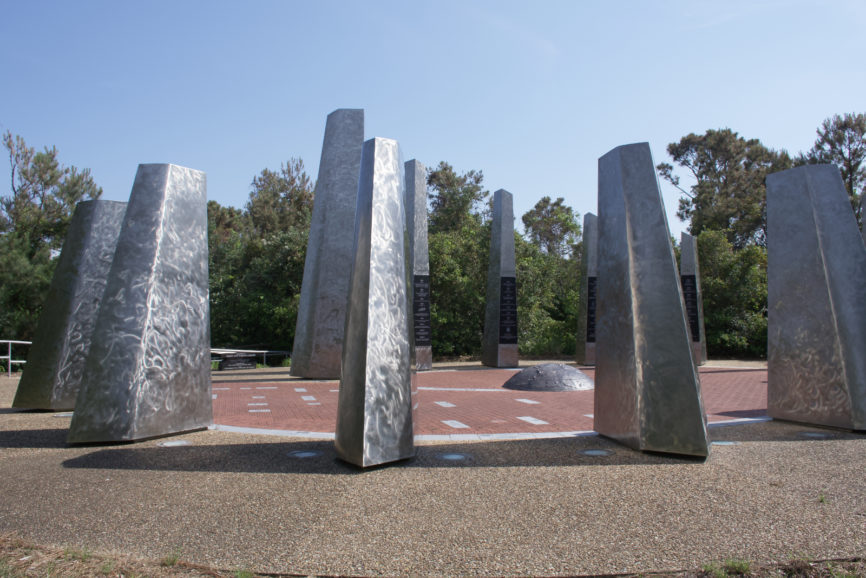Tucked away behind the Aycock Brown Welcome Center in Kitty Hawk, the Monument to a Century of Flight is a remarkable testimony to the spirit of perseverance and creativity that has driven humanity’s exploration of the skies.
Dedicated on November 8, 2003, with its fourteen stainless steel and black granite pylons starting at 10 feet and rising to 20 feet in a concentric design, it gives a sense of flight swirling to the heavens. The pylons themselves are winged shaped with a curved side resembling the leading edge of an airfoil.
The work was a collaborative effort between local artist Glenn Eure and the husband and wife team of internationally renowned sculptures Hannah Jubran and Jodi Hollnagel Jubran who teach at ECU.

It is a beautifully conceived and executed concept in sculpting and history. The first inscription on the pylons reads, “1903 December 17 Kitty Hawk, NC Orville and Wilbur Wright Accomplish World’s First Powered, Controlled, Sustained Manned Flight In Heavier Than Air Machine.
From there, the history of flight is recounted from the Wright Brothers to the final entry marking humanity’s permanent presence in space.
“2000 October First Crew of International Space Station Arrives In Orbit Establishing Continuous Human Presence in Space.”
Along the way, there are the well-known events. Pylon Four includes the 1927 solo flight across the Atlantic by Charles Lindbergh. Certainly, an event that most people know about. But also on that pylon is an entry that is significant but little known.
“1927 air-cooled engine makes lighter, faster plants possible,” reads.
On Pylon One we learn that in “1910 Madame La Baronne de Laroche Becomes First Woman Pilot Licensed.” And on Pylon 10 the first human to exit a spacecraft is noted. “1965 March 18 Soviet Cosmonaut Aleksei Leovov becomes the first man to walk in space.”
It is difficult to differentiate the beauty of the art from the arc of history that the inscriptions describe. The pylons do not move, yet with the sun glinting off the polished stainless steel, and each pylon proportional to the next as they rise to the sky, there is a feeling of movement.
In the center of the Monument, there is a bronze dome that rises from the brick base of the work. On it is a depiction of the earth. Around the base, many of the most significant aircraft that created modern aviation are depicted, and inscribed on it are the words, “When Orville Wright lifted from the sands of Kitty Hawk at 10:35 on the morning of December 17, 1903, we were on our way to the moon and beyond.”
It is a peaceful place to visit. Perched on top of a hill, in the spring and summer birds chirp and sing in the trees. Although US 158, the Croatan Highway, the main route onto the Outer Banks, is nearby, traffic sounds are muted and distant. There is a black granite bench just outside the brick courtyard; the bench is a memorial to Icarus International, the nonprofit formed to fund the monument.
Leaving the Monument there is a black granite marker inscribed with one of the most beautiful and poignant poems about flight ever written.
John MaGee, Jr. was a 19-year-old American, flying with the Royal Canadian Air Force in England in 1941 when he penned High Flight. Soon after he wrote the poem he was killed in a mid-air collision over England.
Oh! I have slipped the surly bonds of Earth
And danced the skies on laughter-silvered wings;
Sunward I’ve climbed, and joined the tumbling mirth
Of sun-split clouds, – and done a hundred things
You have not dreamed of – wheeled and soared and swung
High in the sunlit silence. Hov’ring there,
I’ve chased the shouting wind along, and flung
My eager craft through footless halls of air…
Up, up the long, delirious burning blue
I’ve topped the wind-swept heights with easy grace
Where never lark, or ever eagle flew –
And, while with silent, lifting mind I’ve trod
The high untrespassed sanctity of space,
Put out my hand, and touched the face of God.
The Monument to a Century of Flight is truly a testament to the perseverance and artistic vision of artist Glenn Eure. Well-known on the Outer Banks for his community involvement and commitment to the arts, Eure, who passed away in 2018, shepherded the project from concept to completion.
A time capsule has been placed at the base of the Monument to be retrieved in 2103.





